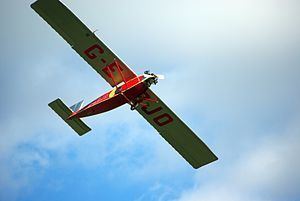Top speed 119 km/h Length 4.75 m | Wingspan 9.75 m First flight 1923 | |
 | ||
Manufacturer Air Navigation and Engineering Company | ||
Anec ii
The ANEC I and ANEC II were 1920s British single-engine ultralight aircraft designed and built by Air Navigation and Engineering Company Limited at Addlestone Surrey. One was privately constructed in Brisbane, Australia.
Contents
Shuttleworth pageant anec ii
History
The ANEC I and II, designed by W.S Shackleton, were amongst the earliest ultralight aircraft; they were very small, wooden, strut braced high-wing monoplanes. The first ANEC I, registered G-EBHR, first flew at Brooklands on 21 August 1923. It was the first aircraft with an inverted engine, a 696 cc Blackburne Tomtit, to fly in the United Kingdom. The ANEC I was designed to the rules of the 1923 Lympne light aircraft trials, principally an engine capacity limit of 750 cc, and the two aircraft completed that August took part. The main prizes were for fuel economy and the second ANEC I G-EBIL, flown by Jimmy James, shared half of the £1,500 prize with an English Electric Wren for flights of 87.5 miles (141 km) on one gallon (4.54 L) of petrol. He later reached an altitude of 14,000 ft (4,267 m) in it. G-EBIL was evaluated by the Air Ministry in 1924, briefly carrying the RAF serial J7506. Afterwards it was modified with a wingspan greatly reduced from 32 ft to 18 ft 4 in (9.75 m to 5.59 m) and re-engined with a 1,000 cc Anzani engine for entry in the 1925 Lympne August Bank Holiday Races, designated the ANEC IA.
Only one more ANEC I was constructed. It was built in Australia by George Beohm, who went on to design the Genairco Biplane, and Horrie Miller. E. W. Beckman, the owner of the aircraft, intended to enter it in the Low-Powered Aeroplane Competition held at Richmond in December 1924, but it was not completed until the following year. The first of the two built in the United Kingdom in 1923, G-EBHR, was exported to Australia in the second half of 1924.
The ANEC II was an enlarged version of the ANEC I built for the 1924 Lympne light aircraft trials competition. Following the revised competition rules, it was a two-seater and its more powerful 1,100 cc Anzani inverted V twin-cylinder had the greatest capacity allowed. The wing area was increased by 28% to accommodate the extra weight by a 5 ft 2 in (1.57 m) span extension. It was also longer by almost the same amount. Engine problems kept it from flying in the competition and out of the Grosvenor Trophy race that immediately followed.
In 1927 a new owner refitted it with a 32 hp (24 kW) Bristol Cherub III flat twin engine, a larger rudder, and a more conventional undercarriage with larger wheels mounted on a cross axle attached to the lower fuselage with a pair of V-struts. In 1931 another new owner fitted a heavier 30 hp (22 kW) ABC Scorpion engine, another flat twin and, to keep the weight down, reworked it as a single seater. It was in this condition when it was acquired by Richard Shuttleworth in about 1937.
Variants
Survivors
The only ANEC II, registered G-EBJO was restored to airworthy condition in 2004, with a single seat, the revised undercarriage and the Scorpion engine. It flies regularly at the Shuttleworth Trust at Old Warden.
Operators
Specifications (ANEC I)
Data from Jackson
General characteristics
Performance
